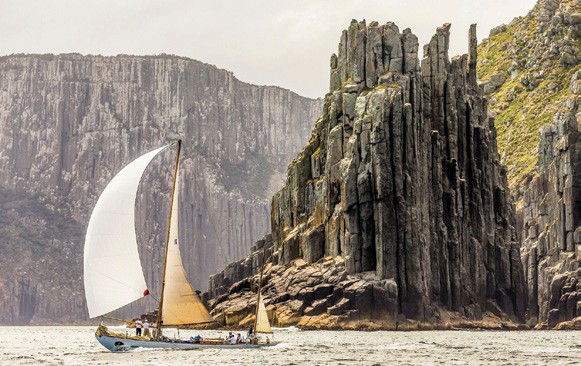 The 86-year-old Sparkman & Stephens yacht Dorade finished second in two divisions (IRC Division 4/ORCi Div 4) in the Rolex Sydney Hobart Race. The 628-mile race, which started December 26, 2017, is often described as one of the most challenging ocean races in the world. It was the pinnacle event in Team Dorade’s ambitious six-race “Dorade Down Under” series, which kicked off this past August in Australia.
The 86-year-old Sparkman & Stephens yacht Dorade finished second in two divisions (IRC Division 4/ORCi Div 4) in the Rolex Sydney Hobart Race. The 628-mile race, which started December 26, 2017, is often described as one of the most challenging ocean races in the world. It was the pinnacle event in Team Dorade’s ambitious six-race “Dorade Down Under” series, which kicked off this past August in Australia.
Dorade off Tasman Island in the Rolex Sydney Hobart Race © Rolex/Studio Borlenghi
“We are very proud of the boat and the crew for their performance in this race, encouraging us for the next round of challenges, which will include more of the world’s great ocean races,” said Dorade co-owner Pam Rorke Levy (San Francisco, CA), adding that the yacht, originally launched in 1929, was the oldest boat in the fleet. “This race opens a new chapter for Dorade and the role we play as her custodians. Now, we’re not just repeating history but making history by taking on new challenges with an iconic and beloved boat.”
Dorade finished the race with an elapsed time of three days, six hours and 38 minutes. The team raced with eight crew onboard, including Sydney Hobart veteran Adrienne Cahalan as navigator. “Many of the boats that compete and win the Sydney Hobart are purpose-built for the conditions down here in the southern oceans,” said Skipper and co-owner Matt Brooks (San Francisco). “Dorade does best in flat water downwind, which isn’t the Sydney Hobart. We lucked out this year, to everyone’s surprise, and had a downwind race, but the seas were anything but flat, and we were rocking and rolling so violently we finally took the spinnaker down. All of us have longer arms now after driving the boat in those conditions.”
Designed in 1929 by 21-year-old Olin Stephens and built under his younger brother Rod Stephens’ supervision, Dorade’s revolutionary design – a deep keel with external ballast, an achingly narrow beam of just 10’3”, and a generous sail plan – took the yachting world by storm, quickly establishing the Stephens brothers as two of the sport’s most gifted innovators. In 1931, the brothers raced Dorade in the Transatlantic Race from Newport, Rhode Island to Plymouth, England, competing against much larger boats owned by some of the world’s wealthiest sportsmen and crewed by veteran sailors. With an upset victory that made headlines around the world, Dorade was the first boat to finish by a margin of more than two days. In the decade that followed, she continued topping the charts in some of the world’s most renowned offshore events, including overall victories in the Fastnet in both 1931 and ‘33 and the TransPacific Race in 1936.
After purchasing Dorade in 2010, Brooks and Rorke Levy spent a year restoring the yacht to its original condition before kicking off the “Return to Blue Water” campaign. Their goal with the campaign was to repeat all of the major ocean races the yacht had won in the 1930s, matching or bettering her original performance in the Transatlantic, Newport Bermuda, Fastnet and TransPacific ocean races. The campaign was successful beyond their wildest dreams, with the team not only bettering Dorade’s original times in all of the races, but also reaching the podium in every race and winning the 2013 Transpacific Yacht Race overall on corrected time, 77 years after Dorade won that race for the first time. In 2015, the campaign wrapped up with stellar performances by an all-star crew, placing second in class in an exceptionally rough and windy 2,800-mile Transatlantic Race, followed by second in class in the Rolex Fastnet Race, where Dorade finished 7th overall out of 356 boats.
For more information, visit Dorade.org.
Kirsten Ferguson at Media Pro International contributed to this report.




